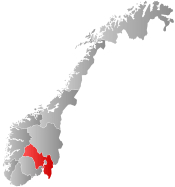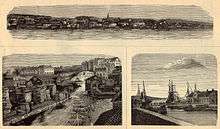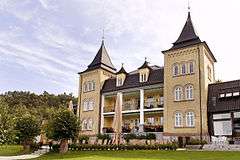Moss, Norway
![]()
Moss kommune | |
|---|---|
 Moss seen from Jeløya | |
 Coat of arms  Viken within Norway | |
 Moss within Viken | |
| Coordinates: 59°27′33″N 10°42′3″E | |
| Country | Norway |
| County | Viken |
| Administrative centre | Moss |
| Government | |
| • Mayor (2017) | Hanne Tollerud (AP) |
| Area | |
| • Total | 63 km2 (24 sq mi) |
| • Land | 58 km2 (22 sq mi) |
| Area rank | 414 in Norway |
| Population (2012) | |
| • Total | 32 570[1] |
| • Rank | 27 in Norway |
| • Density | 440/km2 (1,100/sq mi) |
| • Change (10 years) | 10.6% |
| Demonym(s) | Mossing[2] |
| Time zone | UTC+01:00 (CET) |
| • Summer (DST) | UTC+02:00 (CEST) |
| ISO 3166 code | NO-0104 |
| Official language form | Neutral[3] |
| Website | www |
Its administrative district covers areas east of the town, such as the island of Dillingøy in the lake Vansjø. Parts of the town are located on the peninsula of Jeløy. Moss city has 30,723 inhabitants (2012).
Name
The Old Norse form of the name was Mors. It may be derived from an old root mer- which means to "divide" or "split".
The adjacent topography shares similar etymology:
- Mosse-elva. Mosse -"marsh-river-border"+ Elva -"see Elbe, Elver Old Norse for river" The name is thought to be very old and the meaning of it is not clear.
- Mosse-sundet. Mosse-"marsh-river-border"+ Sundet (Moss channel).
- Mosse-herred. Mosse-"marsh-river-border"+ Herred -"Court" akin to hort(us,en), "garden," from PIE *ghr-ti-, from base *gher- "to grasp, enclose" (see yard) Actually "Moss county".
History
Archeological finds suggest that there were settlements in the area more than 7,000 years ago and continuously through the Iron Age, Viking Age, through to modern times. During the Viking era, the place was known as Varna (forne, vorne, front-protection?) and was the site of a cooperative for battleships held by local warlords on behalf of the king.


The first literary reference to the name Mo(u)ſs(ß) is from Bishop Eystein Aslaksson's Red book (NRA AM fol. 328) from 1396, and by then the town had become a commercial center with craftsmen and mills. By the 16th century, the town's port was significant enough to warrant its own customs official. Liquor distilleries became one of the dominant industries, and it was not until 1607, after the Reformation, that the town got its own church.
By 1700, Moss had become a hub for both ship and land traffic between Copenhagen and Christiania, and in 1704 Moss Jernverk (Moss Ironworks) was established just north of the city center. By 1720 it received its charter as a merchant town, with its own official. This may have had background in an important battle in 1716 that was fought in the town square in Moss in which Norwegian troops commanded by Vincent Budde prevailed over invading Swedish forces, sent by Charles XII to capture Akershus Fortress. In 1767 a local resident built a "pleasure pavilion" near the town, which survives as the Hotel Refsnes Gods.[4]
In 1814, Moss became the site for the signing of the Convention of Moss, which effectively put an end to the Dano-Norwegian kingdom. This set the stage for economic development that has persisted to this day.
On the morning of 14 July 2006, a bolide exploded above the nearby town of Rygge - moments later, several stony meteorites fell over Moss. A number of meteorites were recovered by local residents and visiting meteorite hunters, which after analysis and classification, were found to be a rare type of carbonaceous chondrite.
Coat-of-arms
The coat-of-arms is from modern times. They were granted on 2 April 1954. Moss became a separate city in 1786 and received its first seal in the same year. The seal showed a church under some clouds, the whole thing placed within a circle. Above the circle there were some fasces, the freedom symbol of the late 19th century. A later seal, dating from around 1829, shows the same composition, but now also with six birds flying around the church.
When in the 1930s the city wanted to adopt a coat-of-arms and the birds were chosen as a possible symbol. The original birds probably were doves, symbol of peace. In 1934, the idea of the crow was launched, since the nickname of the inhabitants was 'crows'. The arms were finally granted in 1954 and show a yellow crow on a red background. It was designed by Christian Stenersen.[5][6]
There is a tale being told in Moss about the Church fire: The city of Moss always had a lot of crows, most likely because of the corn being harvested in the region. The fire disturbed the crows that started to make a lot of noise and the inhabitants rescued the church from total destruction. After this episode the idea of crow as arms was launched.
Norwegian lady statues
Moss and Virginia Beach, Virginia in the United States are sister cities. On Good Friday, 27 March 1891, the Norwegian bark Dictator, whose home port was Moss, was lost in the treacherous waters of the Graveyard of the Atlantic. The ship had been en route to England from Pensacola, Florida with a cargo of Georgia Pine lumber. After being caught and disabled in a storm, she was headed for port at Hampton Roads, Virginia to make repairs when she encountered another storm just off Virginia Beach.
Working in the high winds and seas, lifesaving crews from shore were able to save some of the 17 persons aboard. However, the pregnant wife of Captain J.M. Jorgensen, Johanne, and their 4-year-old son Carl were among the 7 persons who drowned.[7]
The ship's wooden female figurehead had washed ashore. It was placed in a vertical position facing the ocean near the boardwalk as a memorial to those who lost their lives in the shipwreck. It was a landmark there for more than 60 years, but gradually became weathered and eroded.
In 1962, Norwegian sculptor Ørnulf Bast was commissioned to create two nine-foot bronze replicas of the original figurehead by the City of Moss. The Norwegian Lady Statues were unveiled on 22 September 1962. One was presented as a gift to Virginia Beach, and an exact duplicate was erected in Moss to unite the two sister cities. Each statue gives the appearance of facing the other across the Atlantic Ocean.
On 13 October 1995, Queen Sonja of Norway visited the Norwegian Lady statue in Virginia Beach, and placed memorial flowers.
Industry
The town is known for paper mills, as well as metalworks and other factories. Dillingøy is known as a place for alternative non-military civil service. Moss is mentioned since the Renaissance and was the site of the signing of the Convention of Moss in 1814, which solidified the union with Sweden. The headquarters of textile producer Helly Hansen were located in Moss until 2009. The maker of international hotel keycards, Trio Ving, also has their headquarters here.
Transport
The railway Østfold Line runs through Moss, stopping at Moss Station, which is the southern terminus of one service of the Oslo Commuter Rail and an intermediate stop for regional trains. Moss connects across the Oslofjord to Horten via the Moss–Horten Ferry. There are also bus-lines to Oslo Airport, Gardermoen, Gothenburg, Copenhagen, Oslo in addition to local bus lines. Moss port is one of the top 3 busiest container ports in Norway (messured in TEUs).
Health care
Together with Østfold Kalnes Hospital, Østfold Moss Hospital covers general health care services for the municipality. The hospital is a modern unit for planned operations. There is a large outpatient and inpatient activity in a number of disciplines, in the field of somatics and mental health care as well as an operation department for both inpatient and day surgery. There is an eye department, imaging services, blood sampling and blood bank and more.[8] The municipality also has three health stations - City center, Bredsand and Kambo health stations.
Sport
Moss FK are the Town's football club. They play in the Second Division, and have played in the Norwegian Premier League as recently as 2002.
Notable people from Moss (Locally called "Mossinger")
Eivind Hellstrøm - Gourmet chef and TV Personality
Ari Behn - Writer
Jon Michelet - Writer
| Ancestry | Number |
|---|---|
| 817 | |
| 660 | |
| 603 | |
| 476 | |
| 331 | |
| 323 | |
| 223 | |
| 191 | |
| 183 | |
| 162 |
International relations
Use of preposition with Moss
"In Moss" is translated i Moss. In the 1800s one said [on Moss] på Moss.[11]
In popular culture
- A traditional expression, [the hay scale at Moss] høyvekta på Moss, means "something that you can not trust".[11]
- Moss is known throughout Norway for the local "dish" "Pølse i Vaffel" - sausage in waffle. The dish consists of a Vienna Sausage served in a Scandinavian style waffle with ketchup and mustard. The dish was most likely created in the 1960s, but this is widely discussed. Eyvind Hellstrøm - who later became a Michelin-star chef - and his brother Jan is often referred to as the creators. Eyvind Hellstrøm has not denied this in interviews.[12][13]
Gallery
 Moss Haffnergaarden
Moss Haffnergaarden- Folkets hus in Moss
 Konvensjonsgården
Konvensjonsgården- Chrystiegården in Moss
 Moss Church in Moss
Moss Church in Moss Hotel Refsnes Gods
Hotel Refsnes Gods
References
- https://www.ssb.no/kommunefakta/moss
- "Navn på steder og personer: Innbyggjarnamn" (in Norwegian). Språkrådet.
- "Forskrift om målvedtak i kommunar og fylkeskommunar" (in Norwegian). Lovdata.no.
- Porter, Darwin; Prince, Danforth (2005), Frommer's Norway, John Wiley and Sons, p. 12, ISBN 0-7645-7826-X
- Norske Kommunevåpen (1990). "Nye kommunevåbener i Norden". Retrieved 2008-12-16.
- "Kråke som byvåpen" (in Norwegian). Moss Kommune. Archived from the original on 2011-10-03. Retrieved 2008-12-16.
- http://www.qsl.net/vbarc/news/1999/mar99.html
- "Sykehuset Østfold Moss". Retrieved 31 May 2020.
- "Immigrants and Norwegian-born to immigrant parents, by immigration category, country background and percentages of the population". ssb.no. Retrieved 24 June 2017.
- "Vennskapsbyer" (in Norwegian). Moss Kommune. Archived from the original on October 3, 2011. Retrieved 2008-12-16.
- Sylfest Lomheim (2015-08-05). "Dølar på Dalen". Klassekampen. p. 10.
- http://www.moss-avis.no/nyheter/nyheter/brodrene-hellstrom-tar-et-oppgjor-med-polse-i-vaffel-pa-tv2s-showman/s/2-2.2643-1.6102568
- http://www.moss-avis.no/nyheter/polse-i-vaffel-har-lang-og-rik-historie-i-moss/s/2-2.2643-1.3946261
External links
|
|
|

